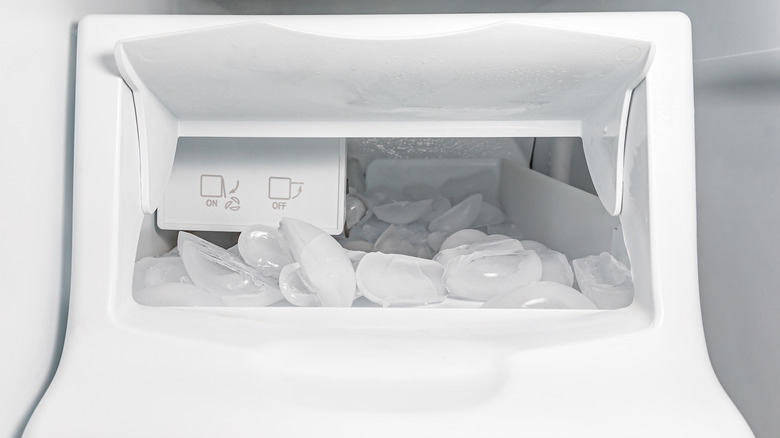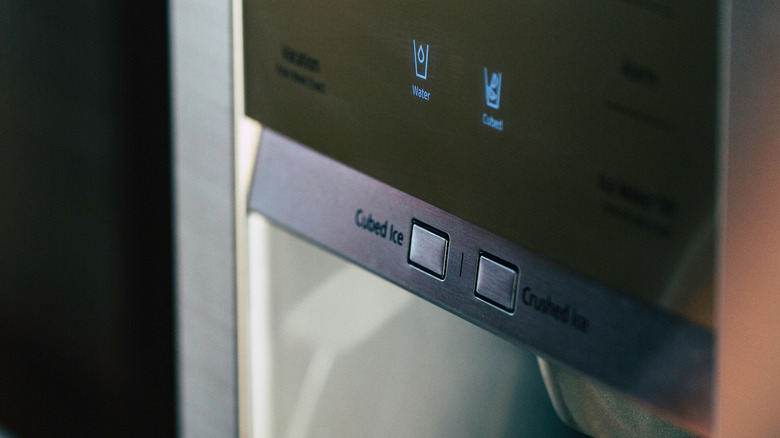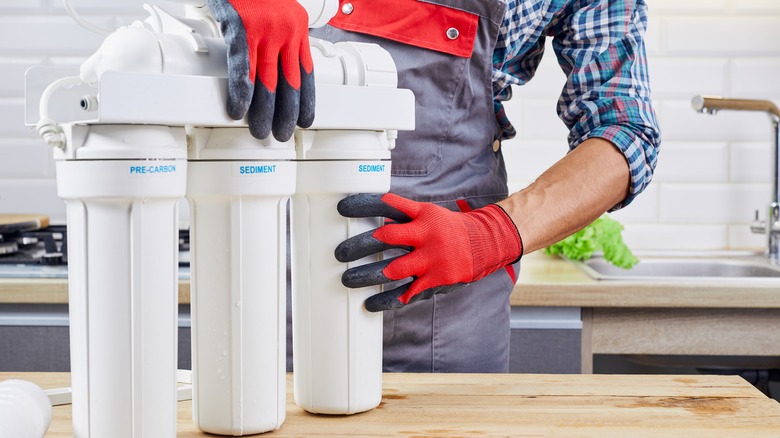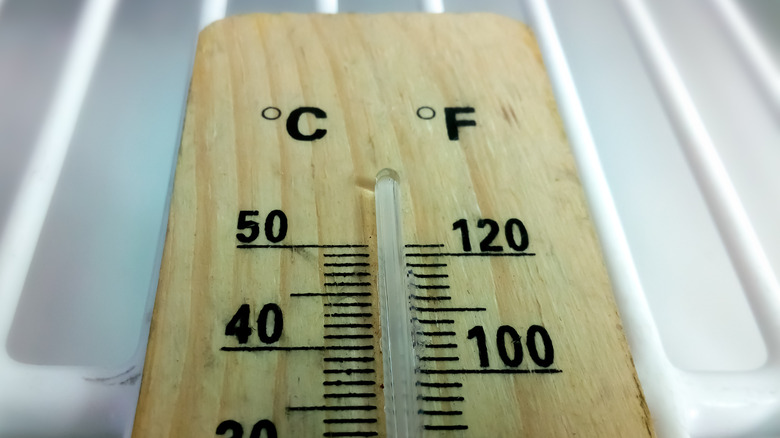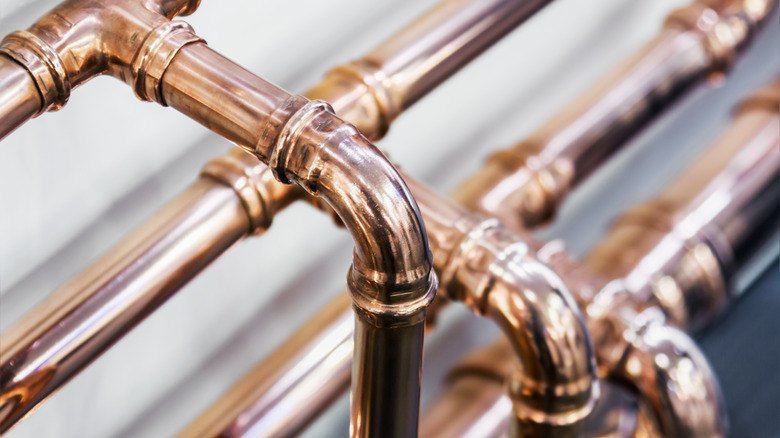5 Tips For Keeping Your Ice Maker Clean
Imagine reaching for some ice to add to your glass of water or tea and discovering that the ice has an odor or adds a weird aftertaste to your drink. You would find that disgusting and a little frustrating, right? Well, there are different ways your ice cubes can get contaminated and give off some of those horrible features, but one of the primary reasons is a dirty ice maker.
Also, if your ice maker makes use of a hard water supply, it could lead to complications such as a build-up of scale. Scales are produced when the calcium and magnesium components of hard water bind together. When scales are present in your ice maker, it could cause you to spend a lot on repairs, according to Easy Ice. Maintaining your ice maker might sound like a lot of hard work. But it's always better to be safe than sorry. According to Fixr, you could spend up to $400 or more on a replacement if you fail to take good care of your ice maker. So here are some tips that can help you keep your ice maker clean.
1. Know the model of your appliance
This might sound like common knowledge, but most people don't know which category their ice maker falls into. This can be a problem when it comes to knowing how to keep your ice maker clean.
Generally, ice makers are divided into two categories: consumer ice makers and commercial ice makers. Some of the consumer ice makers include freezer ice makers, which naturally accompany refrigerators and deep freezers. Under-counter ice makers, meanwhile, are known to come with their own insulated storage bin. The portable ice maker, as the name suggests, is a small-sized portable ice maker that can be easily carried around. And lastly, the free-standing ice maker is like a bigger version of the freezer ice maker (per Whirlpool).
The second category of ice makers — commercial ice makers — are large-sized and mostly employed for business purposes. However, a commercial ice maker still comes with its own level of maintenance. When it's not maintained correctly, it could cause a lot of problems, such as water leaks, leading to a lot of repairs, according to Magic Touch Mechanical.
2. Have cleaning materials on standby
As mentioned, your ice maker could produce less-than-optimal ice as a result of a dirty ice maker. Also, if you happen to use a freezer ice maker, the quality of your ice could be affected by the smell of food stored in the freezer, especially if the ice has been there for a very long time (per Realtor). Thus, it's a good idea to always have your cleaning supplies on standby. One way to tell your ice maker is ready for a cleaning is when the size of the ice reaches or surpasses a quarter inch.
Cleaning your ice maker can be done with a few ordinary tools and supplies, such as clean water, a basin, and a couple of sponges or washcloths. But last, and most importantly, you'll need a cleaning solution, and you can easily DIY one yourself. According to Home Quicks, to clean your ice maker, simply use vinegar and follow the manufacturer's cleaning instructions. If you don't have vinegar, lemon juice will work as a substitute. Also, don't use the first batch of ice following a cleaning; let that work as final a rinse of sorts.
3. Check your ice maker's water filters
Another way to keep your ice maker clean is to ensure your water filter isn't clogged with dirt. Water filters are an important component of your ice maker and they can have a huge effect on your ice supply, as Easy Ice explains. If you live in an area that supplies hard water, having a filter, especially a phosphate filter, can help you avoid a build-up of scale.
Filters come in different categories: There are built-in water filters and in-line water filters, and each one has its own kind of fittings. So it's important to know which one you have in order for you to make the right decision if your water filter requires a change (per The Home Depot). This said, note that it's possible to own a refrigerator that doesn't have a filter at all. This is because these refrigerators usually come with an allowance to bypass the use of a filter. And most of the time, they have a cap in place of the filter, says KitchenSEER.
4. Keep an eye on the thermostat
Most ice makers have thermostats close to the first ice-making mold. Hence, the thermostat ensures the ice maker reaches an appropriate temperature for ice production before it closes, according to GE Appliances. However, as Asurion explains, if you set your thermostat to a very low temperature, it could affect your ice production. This is because the water could get frozen before it gets to the ice-making cup or mold. This, in turn, affects the general cleanliness of your ice maker because you could end up with puddles of defrosted water.
Condenser coils are also a necessary factor here. Condensers are responsible for removing the heat of gas vapor and generally take care of condensation. But according to Easy Ice, the condenser coils can get stuffed up with dirt and completely break down, which affects the efficiency of the ice maker. This also affects the thermostat, which is extremely sensitive to the temperature of the engine of the ice maker. If the engine happens to overheat, it will cause the thermostat to fail, per It Still Runs.
5. Check the water line
If your water line is clogged with debris, it can affect the general quality of your ice supply, says Dan Marc Appliance. And when your ice cubes are contaminated, it would add to the general dirtiness of your ice maker. The water valve comprises solenoids, and if one should stop working, it could stop water flow in the ice maker, affecting ice production. Alternatively, it could cause the water flow to be continuous, which develops into a leakage issue or frozen waterlines, warns Appliance Parts Experts.
The water valve usually comes with a screen that works to remove debris, such as the mineral components that cause hard water as well as other sediments. But after some time, the debris can become bigger and cause a restriction of water flow through the valve or completely stop it (per Popular Mechanics). To keep your ice maker clean as well as preserve your ice production, it becomes imperative to clean the water line valve. This task can be easily executed in a few easy steps, and in no time, you'll have restored water flow (via Ice Maker Parts Shop).
